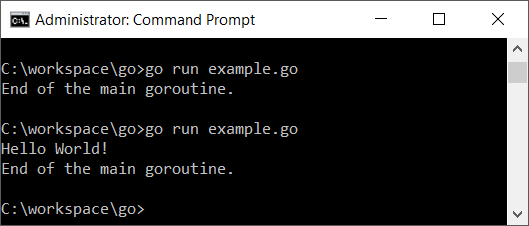Goroutines
A goroutine is a lightweight thread managed by the Go runtime.
To start a goroutine, use keyword go before making the function call as shown in the following.
go somefunc(arg1, arg2)When the above statement is executed, the statement itself gets executed in the current goroutine, but somefunc(arg1, arg2) gets executed in a new goroutine.
Example
In the following program, we will implement a goroutine and call a function to print a message.
example.go
package main
import "fmt"
func printmessage(s string) {
fmt.Println(s)
}
func main() {
// a goroutine
go printmessage("Hello World!")
// another go routine
go printmessage("Welcome to Go Goroutines.")
fmt.Println("End of the main goroutine.")
}Output

Try running this program, using go run command in command prompt or terminal. You may or may not see the strings passed to printmessage() function in the goroutines printed to the console. It is because, when you run the program, the other goroutines as well run on the same address space and access the same shared memory and resources.
If the main goroutine or other goroutine is accessing console output to print the message, and if at the same time other goroutine checks for a console output device, it might find the console output to be in use. Hence, the string will not be displayed.
Conclusion
In this Go Tutorial, we learned about Goroutines with the help of example programs.
